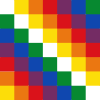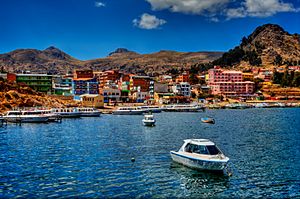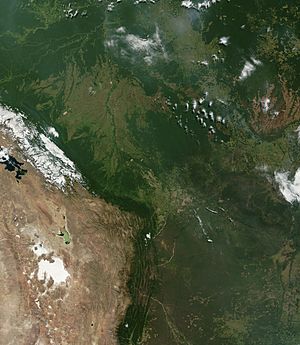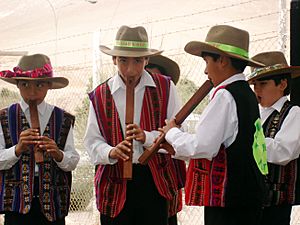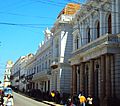Bolivia facts for kids
Quick facts for kids
Plurinational State of Bolivia
|
|
|---|---|
|
|
|
|
Anthem: Himno Nacional de Bolivia (Spanish)
"National Anthem of Bolivia" |
|
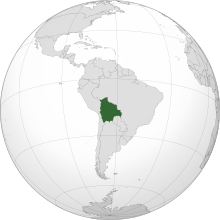
Location of Bolivia (dark green)
in South America (gray) |
|
| Capital | Sucre |
| Administrative center | La Paz |
| Largest city | Santa Cruz de la Sierra 17°48′S 63°10′W / 17.800°S 63.167°W |
| Official languages | |
| Ethnic groups
(2009)
|
|
| Religion
(2020)
|
|
| Demonym(s) | Bolivian |
| Government | Unitary presidential republic |
| Luis Arce | |
| David Choquehuanca | |
|
• President of the Senate
|
Andrónico Rodríguez |
| Legislature | Plurinational Legislative Assembly |
| Chamber of Senators | |
| Chamber of Deputies | |
| Independence
from Spain
|
|
|
• Declared
|
6 August 1825 |
|
• Recognized
|
21 July 1847 |
|
• Current constitution
|
7 February 2009 |
| Area | |
|
• Total
|
1,098,581 km2 (424,164 sq mi) (27th) |
|
• Water (%)
|
1.29 |
| Population | |
|
• 2024 census
|
11,312,620 (84th) |
|
• Density
|
10.4/km2 (26.9/sq mi) (224th) |
| GDP (PPP) | 2023 estimate |
|
• Total
|
|
|
• Per capita
|
|
| GDP (nominal) | 2023 estimate |
|
• Total
|
|
|
• Per capita
|
|
| Gini (2021) | ▼ 40.9 medium |
| HDI (2022) | medium · 120th |
| Currency | Boliviano (BOB) |
| Time zone | UTC−4 (BOT) |
| Date format | dd/mm/yyyy |
| Driving side | right |
| Calling code | +591 |
| ISO 3166 code | BO |
| Internet TLD | .bo |
Bolivia (officially called the Plurinational State of Bolivia) is a country in South America. It is a landlocked nation, meaning it has no coastline. Bolivia is surrounded by Brazil, Paraguay, Argentina, Peru, and Chile.
The country is named after Simón Bolívar, a famous leader who helped many South American countries gain independence. The main languages spoken in Bolivia are Spanish and Quechua. However, many other local languages are also spoken. In 2013, Bolivia had a population of about 10.67 million people.
Contents
Bolivia's Past: A Brief History
Bolivia was once a colony of Spain. Spanish rulers used the country's rich silver mines to make a lot of money. Many Bolivians were forced to work in these mines.
After many battles and struggles, Simón Bolívar played a key role in helping Bolivia become an independent country. This happened on August 6, 1825.
Exploring Bolivia's Geography
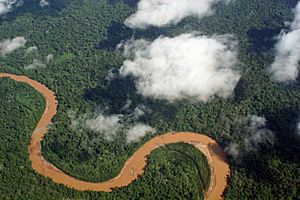
Bolivia is located in the middle of South America. It covers a huge area of about 1,098,581 square kilometers (424,163 square miles). This makes it the 28th largest country in the world and the fifth largest in South America.
The country's landscape is very diverse. It stretches from the high Andes mountains to parts of the Gran Chaco, Pantanal, and even the Amazon rainforest. Bolivia is known for its amazing biodiversity, meaning it has many different kinds of plants and animals.
Different Regions of Bolivia
Bolivia has three main geographical regions:
- The Andean Region: This area is in the southwest and covers about 28% of Bolivia. It's very high up, mostly above 3,000 meters (9,800 feet) above sea level. Here you'll find two large mountain ranges, the Western Range and the Central Range. Some of the highest peaks in the Americas are here, like Nevado Sajama (6,542 meters or 21,463 feet) and Illimani (6,462 meters or 21,194 feet).
- Lake Titicaca: This famous lake is also in the Andean region. It's the highest lake in the world where boats can travel for business, and it's the largest lake in South America. Bolivia shares it with Peru.
- Salar de Uyuni: This is the world's largest salt flat. It's a huge, flat area covered in salt and is an important source of lithium.
- The Sub-Andean Region: Located in the center and south, this region is a middle ground between the high Andes and the eastern plains. It makes up about 13% of Bolivia. This area includes valleys and the Yungas region. It's known for its farming and mild weather.
- The Llanos Region: This is the largest region, covering 59% of Bolivia, in the northeast. It's a flat area with small plateaus, mostly covered by dense rainforests. This region is full of incredible biodiversity and is generally below 400 meters (1,300 feet) above sea level.
Bolivia's River Systems
Bolivia has three main river systems, called drainage basins:
- The Amazon Basin: This is the largest basin, covering about 66% of Bolivia. Rivers here often form large loops and lakes. The main Bolivian river flowing into the Amazon is the Mamoré River. Other important rivers include the Beni River and the Madre de Dios River.
- The Río de la Plata Basin: This basin is in the south and covers about 21% of the country. Its rivers are generally smaller than those in the Amazon Basin. Key rivers here are the Paraguay River, Pilcomayo River, and Bermejo River.
- The Central Basin: This unique basin covers 13% of Bolivia. It's an endorheic basin, meaning its lakes and rivers don't flow into any ocean. They are surrounded by the Andes mountains. The most important river is the Desaguadero River, which flows from Lake Titicaca to Lake Poopó. This basin also includes the large salt flats like the Salar de Uyuni.
Bolivia's Climate Zones
Bolivia's climate changes a lot depending on the region. It can be tropical in the east and very cold, like a polar climate, in the western Andes.
- Llanos (Eastern Plains): This area has a tropical climate that is warm and humid, with an average temperature of 25°C (77°F). Winds from the Amazon rainforest bring a lot of rain. Sometimes, cool winds from the south, called surazos, can make temperatures drop for a few days.
- Altiplano (High Plains): This region has a desert-like and polar climate with strong, cold winds. Temperatures usually range from 15 to 20°C (59 to 68°F) during the day. However, at night, temperatures drop sharply, often close to freezing. Frost is common, and it snows frequently.
- Valleys and Yungas: These areas have a temperate climate. Humid winds from the northeast are pushed up by the mountains, making this region very wet and rainy. Higher elevations are cooler, and snow can fall at altitudes above 2,000 meters (6,500 feet).
- Chaco: This region has a subtropical semi-arid climate. It's rainy and humid in January, but the rest of the year has warm days and cold nights.
People of Bolivia: Demographics
Bolivia has a population of about 10.9 million people. The people of Bolivia come from different backgrounds:
- About 55% are Native American.
- About 30% are Mestizo, meaning they have mixed European and Indigenous heritage.
- About 15% are White.
Bolivia's Economy and Tourism
Bolivia faces challenges with poverty, as about 75.7% of its people live below the poverty line.
The country has the second-largest natural gas reserves in South America. Bolivia sells a lot of this natural gas to Brazil.
Tourism in Bolivia
Tourism is becoming more and more important for Bolivia's economy. The country offers many different attractions because of its rich culture, varied landscapes, long history, and delicious food.
Some of the most popular places to visit include Nevado Sajama, Torotoro National Park, Madidi National Park, Tiwanaku, and the city of La Paz.
One of Bolivia's most famous festivals is the "Carnaval de Oruro". UNESCO recognized it as one of the first "Masterpieces of the Oral and Intangible Heritage of Humanity" in 2001.
How Bolivia is Divided
Bolivia is divided into nine main areas called departments. These departments are then split into 112 smaller areas called provinces. The provinces are further divided into 339 municipalities and special native community lands.
| Territorial division of Bolivia | ||||||
| Department | Abbreviation (ISO) |
Population | Surface (km²) | Density | Capital city | 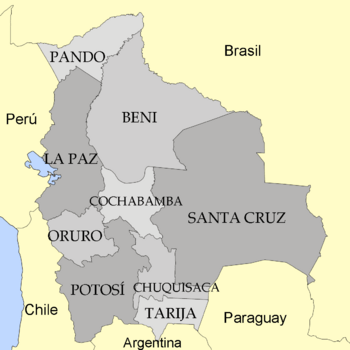 |
|---|---|---|---|---|---|---|
| BO | 10.027.644 | 1.098.581 | 9,1 | Sucre | ||
| BO-B | 430.049 | 213.564 | 1,9 | Trinidad | ||
| BO-H | 631.062 | 51.524 | 11,9 | Sucre | ||
| BO-C | 1.786.040 | 55.631 | 22,7 | Cochabamba | ||
| BO-L | 2.756.989 | 133.985 | 19,9 | La Paz | ||
| BO-O | 444.093 | 53.558 | 8,2 | Oruro | ||
| BO-N | 75.335 | 63.827 | 1,1 | Cobija | ||
| BO-P | 780.392 | 118.218 | 6,5 | Potosí | ||
| BO-S | 2.626.697 | 370.621 | 7,1 | Santa Cruz de la Sierra | ||
| BO-T | 496.988 | 37.623 | 12,5 | Tarija | ||
| Source: Demographic Projections 2008, Bolivian National Demographic Institute. The departmental densitiy has been calculated with the population of 2006. | ||||||
Bolivia's Amazing Biodiversity
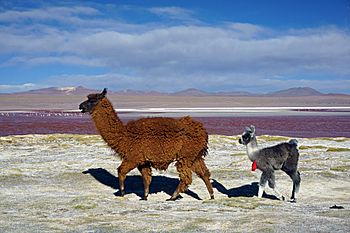
Bolivia is considered one of the "Megadiverse Countries" because it has an enormous variety of living things and natural environments.
The country's different altitudes, from 90 meters (300 feet) to 6,542 meters (21,463 feet) above sea level, create a huge range of biological diversity. Bolivia has four main types of biomes, 32 ecological regions, and 199 different ecosystems.
There are many national parks and reserves, like the Noel Kempff Mercado National Park and the Madidi National Park. These places protect Bolivia's incredible nature.
Plants and Animals of Bolivia
Bolivia is home to over 17,000 species of seed plants. This includes more than 1,200 types of ferns and 800 kinds of fungus. Over 3,000 species of medicinal plants also grow here.
Bolivia is believed to be where many important plants first grew. These include peppers and chili peppers, peanuts, common beans, and yucca. The country also naturally produces over 4,000 different kinds of potatoes!
Bolivia has more than 2,900 animal species. This includes 398 mammals, over 1,400 birds (about 14% of all known bird species in the world!), 204 amphibians, 277 reptiles, and 635 types of fresh water fish. Since Bolivia is a landlocked country, it has no saltwater fish. You can also find over 3,000 kinds of butterfly and more than 60 types of domestic animals.
Bolivian Culture
Bolivian culture is a mix of influences from the Inca, Aymara, and other native groups. These influences can be seen in their religion, music, and clothing.
A very popular festival is "El carnaval de Oruro". People in Bolivia love playing football, which is often played right in the street.
National Symbols
The Cantuta (also called kantuta or qantuta) is a beautiful flower found in the Yungas region. It is one of Bolivia's national flowers. The other is the patujú (Heliconia rostrata), which grows in the tropical areas of Bolivia.
Related pages
Images for kids
-
Former President, Evo Morales
-
Inauguration of Luis Arce and David Choquehuanca on 8 November 2020
-
Mururata as seen from the tropical valleys of the Yungas
-
Chacaltaya ski resort, La Paz Department
-
Bolivia's national animal, the llama
-
Danza de los macheteros, typical dance from San Ignacio de Moxos, Bolivia
-
Aymara man, near Lake Titicaca, Bolivia
See also
 In Spanish: Bolivia para niños
In Spanish: Bolivia para niños




